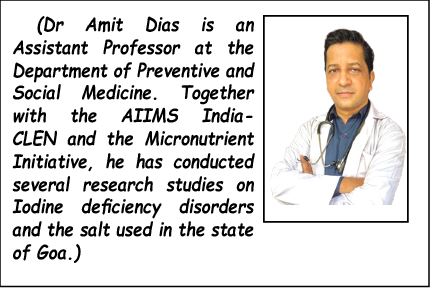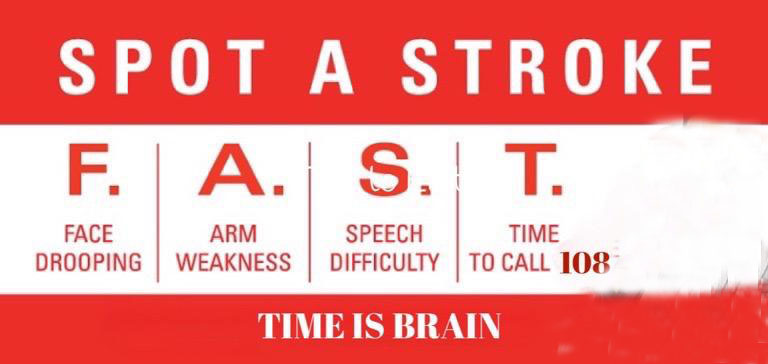A world stroke awareness day special!
OCTOBER 29 is observed as World Stroke Awareness Day. We got to speak to DR AMIT DIAS from the Department of Preventive & Social Medicine, Goa Medical College, to understand why stroke strikes and what can be done if it does. “You need to recognize the signs and act FAST: Time is BRAIN,” he says as he shares some crucial information that everyone needs to know. All this and more in this informative interview.
Goan Observer: Let’s start with the basics. What is a brain stroke?
Dr Amit Dias: A brain stroke is a condition that occurs when the blood supply to part of the brain is interrupted or reduced, thus preventing the brain tissue from getting oxygen and nutrients. Brian’s cells begin to die and every second is precious. Stroke is a medical emergency and immediate medical intervention is necessary to reduce brain damage and disability. There are a lot of advances in the management of stroke, but for that, the person needs to get to an appropriate center FAST.
GO: So it’s very important to recognize a stroke immediately! Can you tell our readers what are the early signs to spot a stroke?
AD: Recognizing the signs of a stroke is crucial for prompt treatment. The most common symptoms include sudden numbness or weakness in the face, arm, or leg, particularly on one side of the body. Other signs can be sudden confusion, trouble speaking or understanding speech, difficulty walking, dizziness, loss of balance, or a sudden severe headache. If you or someone you know experiences these symptoms, it’s essential to seek medical attention FAST.
Remember the word FAST, it tells us a lot about how to spot a stroke.
F- Stands for Facial deviation. Ask the person to smile. Is the person’s smile uneven? Is the face drooping or numb?
A- Stands for arm weakness. Ask the person to raise their arms and check if one side drifts downwards. Is one arm weak or numb?
S- Stands for ‘Speech Difficulty.’ Ask the person to make a sentence and check if the speech is slurred.
T- Stands for ‘Time’. You need to get to a center that can treat stroke immediately. Call 108 immediately and get to the right place. Note the time when the first symptom appears and remember every minute counts…. the brain cells are dying and you need to get to a place that can reverse the damage immediately to prevent further cell death. That’s why we say is TIME IS BRAIN!
GO: How big a problem is a stroke, both in India and globally?
AD: Stroke is a significant public health issue both in India and worldwide. Globally, it is a leading cause of death and disability.
The lifetime risk of developing a stroke according to the WHO is one is four. From 1990 to 2019 there has been a 70% increase incidence of stroke, a 43% increase in the deaths due to stroke, and a 143% increase in what is called the disability-adjusted life years due to stroke. What is more startling is that the bulk of the global stroke burden is in low and middle-income countries. This poses an unprecedented burden on the families who have to look after a loved one with a disability with very few resources.
In India, the prevalence of stroke has been on the rise due to various factors, including lifestyle changes, an aging population, and increased risk factors like hypertension and diabetes.
GO: What are the risk factors for a stroke that individuals should be aware of?
AD: Several risk factors can increase one’s likelihood of experiencing a stroke. These include:
Hypertension (high blood pressure): It’s a significant risk factor for stroke.
Diabetes: Poorly managed diabetes can increase the risk of stroke.
High cholesterol: Elevated levels of LDL cholesterol can contribute to the development of atherosclerosis, which narrows the arteries and increases stroke risk.
Smoking: Tobacco use significantly raises the risk of stroke.
Obesity: Being overweight or obese increases the likelihood of other stroke risk factors like hypertension and diabetes.
Physical Inactivity: Lack of regular exercise can lead to various risk factors, including obesity and high blood pressure.
Family history: A family history of stroke or cardiovascular disease can also increase an individual’s risk.
Age: The risk of stroke increases with age, especially after 55.
Awareness of these risk factors is crucial for prevention. One needs to adopt a healthy lifestyle to prevent a stroke.
GO: If someone does have a stroke, what can be done to help them?
AD: As I mentioned earlier, time is the brain. One needs to act fast. Quick medical intervention can make a significant difference. If you suspect someone is having a stroke, follow these steps:
Call 108 or emergency ambulance services: Do this immediately to get professional help.
Stay with the person: Keep them calm and reassure them that help is on the way.
Note the time: Remember when the symptoms first appeared; this will help medical professionals determine the best treatment.
Don’t give the stroke patient anything to eat or drink: Swallowing may be difficult, and it’s essential to prevent choking.
The stroke treatment can vary depending on the type and severity, but it may include medication, clot-dissolving drugs, and in some cases, surgery. Rehabilitation and physical therapy are crucial for recovery.
GO: Is there a specific period during which getting care is most effective for a stroke?
AD: Yes, for ischemic strokes, which are caused by a clot, there’s a time window for administering clot-dissolving medication, typically within 4 hours of symptom onset. After this time, the risks may outweigh the benefits.
GO: Thank you, Dr Dias, for sharing your expertise on this critical topic. Your insights will undoubtedly help raise awareness about stroke and the importance of early intervention. Any final words for our readers?
AD: Yes remember to recognize the signs of a stroke, act FAST and get to a facility that can intervene appropriately. Time is BRAIN. Stay safe and always remember that prevention is better than cure.

